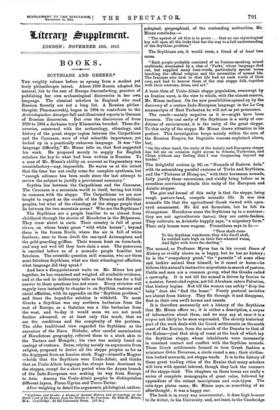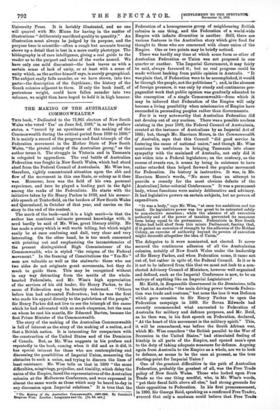BOOKS.
SCYTHIANS AND GREEKS.*
THE weighty volume before us sprang from a modest yet truly philanthropic intent. About 1889 Russia adopted the natural, but to the rest of Europe discomforting, practice of publishing her own archaeological discoveries in her own language. The classical scholars in England who read Russian fluently are not a long list. A Russian philan- thropist, Pharmacovskij, began in 1904 to contribute to the Archdologischer-Anzeiger full and illustrated reports in German of Russian discoveries. But over the discoveries of from 1889 to 1904 a darkness truly Kimmerian brooded. These dis- coveries, concerned with the archaeology, ethnology, and history of the great steppe region between the Carpathians and the Caucasus, were of vital scientific importance, yet locked up in a practically unknown language. It was " the language difficulty," Mr. Minns tells us, that first suggested his work. He proposed merely to supply for English scholars the key to what had been written in Russian. To a man of Mr. Minns's ability an account so fragmentary was unsatisfactory—nay, impossible. He warns us at the outset that the time has not really come for complete synthesis, but "enough advance has been made since the last attempt to review the subject to justify a provisional summary."
Scythia lies between the Carpathians and the Caucasus. The Caucasus is a mountain world to itself, having but little in common with the steppe. The Carpathians we are now taught to regard as the cradle of the Thracian and Hellenic peoples, but what of the ethnology of the steppe people that lie between the two mountain areas ? Who are the Scythians
The Scythians are a people familiar to us almost from childhood through the stories of Herodotus in the Melpomene. They roam about in carts. Their country is full of great rivers, on whose banks graze " wild white horses"; beyond them is the frozen North, where the air is full of white feathers ; near to them dwell the one-eyed Arimaspians and the gold-guarding griffins. Their women hunt on horseback, and may not wed till they have slain a man. The panorama is unrolled before us of a nomadic people familiar but fabulous. The scientific question still remains, who are these semi-fabulous Scythians, what are their ethnological affinities, what language did they speak ?
And here a disappointment waits us. Mr. Minns has put together, he has examined and weighed all available evidence, and at the end he deliberately tells us that the time for a full answer to these questions has not come. Every reviewer will eagerly turn instantly to chapter iv. on Scythian customs and racial affinities, with its appendix on the " Scythian problem," and there the hoped-for solution is withheld. To most Greeks a Scythian was any northern barbarian from the east of Europe, as a Galatian was a like barbarian from the west, and to-day it would seem we are not much further advanced, or at least only this much, that we see the conditions and the complexity of the problem. The older traditional view regarded the Scythians as the ancestors of the Slays. Niebuhr, after careful examination of Herodotean geography, referred them to a stock akin to the Tartars and Mongols ; his view was mainly based on analogy of customs. Zeuss, relying mainly on arguments from religion, proposed to derive all the steppe peoples as far as the Argippaei from an Iranian stock. Nagy—himself a Magyar —holds that the Scythians were Uralo-Altaic, and thinks that an Uralo-Altaic language has always been dominant in the steppes, except for a short period when the Aryan branch of the Indo-Europeans was making its way from Europe to Asia. Among the Uralo-Altaic peoples he distinguishes different layers, Finno-Ugrian and Turco-Tartar.
After weighing in detail the arguments, philological, anth ro-
• Scythians and Greeks: a Survey of Ancient History and Archaeology on the North Coast of the Euxine, from the Danube to the Caucasus. By Ellis 11. Minns, M.A. Cambridge: At the University Press. LE3 3s.]
pological, geographical, of the contending authorities, Mr. Minns concludes :—
" The upshot of all this is to prove . .. that no one etymological key will open all the locks that bar the way to a full understanding of the Scythian problem."
The Scythians are, it would seem, a blend of at least two races.
"Each people probably consisted of an Iranian-speaking mixed multitude, dominated by a clan of 'Turks,' whose language died out, but supplied many loan-words, particularly special terms touching the official religion and the necessities of nomad life. The Iranians who took to that life had no such words of their own, and had to borrow them of the real steppe folk, together with their customs, dress, and art."
A basis then of Uralo-Altaic steppe population, overswept by an Iranian wave, is the view to which, with the utmost reserve,
Mr. Minns inclines. On the new possibilities opened up by the discovery of a centum Indo-European language in the Le Coq manuscripts of East Turkestan he will not as yet pronounce.
The result—mainly negative as it is—might have been foreseen. The real unity of the Scythians is a unity of con- ditions of environment, it is the unity of the great steppe. To this unity of the steppe Mr. Minns draws attention in his preface. This investigation keeps mainly within the area of the Russian Empire, for linguistic reasons explained above, but,
"On the other hand, the unity of the Asiatic and European steppe has led me on occasion right across to Siberia, Turkestan, and China without any feeling that I was trespassing beyond my border."
The delightful section (p. 96) on "Nomads of Eastern Asia," with its astonishing parallel customs of Turks and Scythians, and the "Pictures of Hiung-nu," with their horseman nomads, fully justify these excursions, and vividly bring before us in countless convincing details this unity of the European and Asiatic steppes.
The gist and kernel of this unity is that the steppe, being rough pasture-land, compels nomadic life. It was this nomadic life that the agricultural Greek viewed with open- eyed amazement. He did not formulate, but he felt its strangeness. Herodotus sums the Scythians up in a sentence: they are not agriculturists (&porat), they are cattle-feeders. They cultivate, as Aristotle happily says, "a migratory farm."
Their only homes were wagons. Prometheus says to to :—
" Thou shalt come To the Scythian wanderers, they who dwell aloft, In wattled huts high on their fair-wheeled wains, And fight with bows far-darting."
The nomad, as Professor Myres has in his recent Dawn of History so vividly shown us, is happy, but he has no history;
he is the " compulsory guest," the " parasite " of some other and luckier animal than himself, be it camel or horse—he
follows this animal's instinctive migrations in search of pasture. Cattle and men are a common group, what the Greeks called a syntrophy. It is not till the nomad is driven by famine to a moister, forest-clad region, not till Abraham enters Palestine, that history begins. Not till the woman can safely " drop the
baby " does she " find the home." Purely pastoral societies are absent from history. They flit through it and disappear, fleet as their own swift horses and camels.
It is therefore necessarily not a history of the Scythians that Mr. Minns offers us ; it is rather a description, a corpus of information about them, and we may say at once it is a corpus not likely to be soon superseded. The strictly historical
part of the work deals with the Greek settlements on the north coast of the Euxine, from the mouth of the Danube to that of the Kuban—just that strip of coast at the back of which lay the Scythian steppe, whose inhabitants were necessarily in constant contact and conflict with the Scythian nomads.
These Greek settlements formed in true Greek fashion a miniature Orbis Terrarum, a circle round a sea; their civilisa-
tion looked seawards, not steppe-wards. It is to the history of these great trading cities of the Euxine that many scholars will turn with special interest, though they lack the romance of the steppe-land. The chapters on these towns are really a series of complete monographs of great value, followed by appendices of the extant inscriptions and coin-types. The coin-type plates came, Mr. Minns says, as something of an afterthought ; it was a happy one.
The book is in every way monumental ; it does high honour to its writer, to his University, and, not least, to the Cambridge University Press. It is lavishly illustrated, and no one will quarrel with Mr. Minns for having in the matter of illustrations " deliberately sacrificed quality to quantity." An illustration must always be judged by its purpose, and the purpose here is scientific—often a rough but accurate tracing shows up a detail that is lost in a more costly phototype. The bibliography is of rare intelligence, giving a real guide to the reader as to the purport and value of the works named. We have only one mild discontent—the book leaves us with a certain sense of lack of unity, or at least with a sense of unity which, as the author himself says, is merely geographical. The subject really falls asunder, as we have shown, into two parts—the description of the Scythians; the history of the Greek colonies adjacent to them. If only the book itself, of portentous weight, could have fallen asunder into two volumes, we might then have hoped to hold it in high honour.































































 Previous page
Previous page